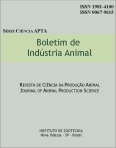Mineral content in Africanized honey bees Apis mellifera (Hymenoptera:Apidae) honey samples from some municipalities of the State of Ceara, Brazil
Keywords:
Apis mellifera, Ceara, honey, mineral contentAbstract
Brazil has as important place among honey producing countries, since it is suitable for apiculture in terms of the flowers. In State of Ceará, Northeast region of Brazil, despite of floral diversity and potential for apicultural exploration, few information exists on the presence of chemical elements in honey. The objective of this research was to verify the mineral content in honey samples produced in Ceara, NE, Brazil (Araripe: 1 sample; Santana do Cariri: 1 sample; Assare: 1 sample; Iguatu: 8 samples; Crato: 4 samples; Missão Velha: 2 samples and Pacajus: 3 samples). The samples were collected directly by the beekeepers and were analyzed at the €œLaboratório de Apicultura€ at ESALQ (Escola Superior de Agricultura €œLuiz de Queiroz€) and €œLaboratório de Instrumentação Nuclear€ at CENA (Centro de Energia Nuclear na Agricultura) / €œUniversidade de São Paulo€, Piracicaba, São Paulo, Brazil. The mineral content was determined by using the total reflection X-ray fluorescence. The result mean of three replication were: K (313.162± 102.85), Ca (33.598±24.497), Ti (0.282±0.184), Cr (0.242±0.11), Mn (1.357±0.4611), Fe (2.939±1.208), Co (0.071), Ni (0.060±0.029), Cu (0.265±0.068), Zn (16.59±30.53), Se (0.054), Br (0.348±0.21), Rb (0.998±0.299), Sr (0.652±0.627), Ba (2.041), Hg (0.518) and Pb (not detected) μg.g -1.
Downloads
Downloads
Published
Issue
Section
License
Os autores não serão remunerados pela publicação de trabalhos, pois devem abrir mão de seus direitos autorais em favor deste periódico. Por outro lado, os autores ficam autorizados a publicar seus artigos, simultaneamente, em repositórios da instituição de sua origem, desde que citada a fonte da publicação original seja Boletim de Indústria Animal. A revista se reserva o direito de efetuar, nos originais, alterações de ordem normativa, ortográfica e gramatical, com vistas a manter o padrão culto da língua e a credibilidade do veículo. Respeitará, no entanto, o estilo de escrever dos autores. Alterações, correções ou sugestões de ordem conceitual serão encaminhadas aos autores, quando necessário. Nesses casos, os artigos, depois de adequados, deverão ser submetidos a nova apreciação. As opiniões emitidas pelos autores dos artigos são de sua exclusiva responsabilidade. Todo o conteúdo deste periódico, exceto onde está identificado, está licenciado sob a Licença Creative Commons Attribution (CC-BY-NC). A condição BY implica que os licenciados podem copiar, distribuir, exibir e executar a obra e fazer trabalhos derivados com base em que só se dão o autor ou licenciante os créditos na forma especificada por estes. A cláusula NC significa que os licenciados podem copiar, distribuir, exibir e executar a obra e fazer trabalhos derivados com base apenas para fins não comerciais.













